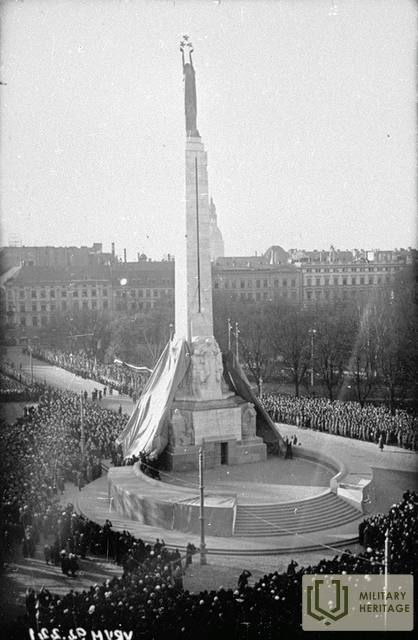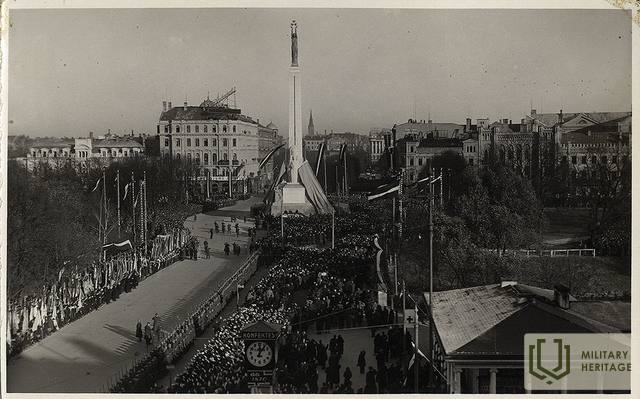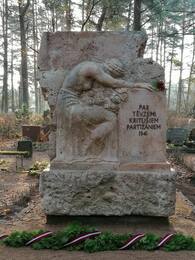Karlis Hall and Freedom Monument
The narrator describes the memories of Kārlis Zāles as a personality who created the most famous works of Latvian art. The description is dedicated to the memory of Zāles in 1942 (the year of K. Zāles' death). The memories were chosen to characterize K. Zāles' works based on the author's personal characteristics and perception of the world.
“(..) In his life and works, Zāle’s personality has developed from his inner center. Zāle is one of those people who, when meeting him, could immediately feel the inner core behind the exterior, something essential. This core was embedded in his vitality. Innate powers, the heritage of Kursian ancestors, are the great dowry that Laima placed in the cradle of Kursa’s son. Nature had lavishly endowed Zāle with this vitality. An indefatigable vitality flowed in the sculptor’s posture, in every gesture, in the expressive play of features and in his language, giving everything a peculiar freshness and juiciness. From the fertile vital layer, his fantasy burst forth briskly and spontaneously, his lively thought burst forth. From here arose everything that was original and healthily primitive in Zāle’s life and work. This unbreakable store of rustic forces broke its way through life and overcame difficulties. In artistic creation, it gave us the opportunity to say something of our own and something new, to stand out in the first places, achieving outstanding achievements in our monumental sculpture. In this art region, we did not have our own traditions that had grown up in the circle of modern culture, which began to form in the Latvian painting region since the end of the last century. Thus, we could quite easily succumb to the influence of the old cultural peoples, remaining imitators and descendants. "If this did not happen, if in a relatively short time our best sculptors in the field of monumental sculpture were able to create something original and noteworthy, then we must thank the rustic foundation of our life for it. Zāle expresses this ancient layer with deep and instinctive security. The forms of modern artistic expression were thus able to grow from the roots of rustically fresh primitiveness, seeing behind the decoration of present-day culture the ancient wisdom and beauty in its - one would like to say - barbaric splendor and greatness (..)"
“(..) We, said the master, should not be ashamed and run away from ourselves and the time in which we stand, but should be who we are — Latvian artists. If you are an artist, show the power of your land, its blessings and beauty, show the workers in their efforts, show the mother, the guardian of the family hearth, the protector of the fatherland, show all this with respect, with warm feelings and reverence, so that others can see who we are and respect us. But if you make them look like cripples in your inept depictions, if you smear the faces of peasants and workers with mud, making them look like dumb animals, show them crooked and broken like slaves or criminals, — you have slandered and spat on your people. Such a fool should better throw away his brushes and go dig ditches or Do some other, more useful work. How can others respect you if you don't know how to respect yourself? Being an artist doesn't mean gliding around the outside of life and random trifles, but it means searching for the core and nucleus in nature and people. Dilettantes stick to random trifles and don't see the main thing, while other dilettantes tinker with form and rejoice as if in happy coincidences. If I spit, my spit will sometimes spill out with some kind of twists and drops, but is that how a serious artist should approach his art? Only amateur scoundrels who show off their every stupidity act like that, but not serious painters. Connoisseur and dilettante - these were bitter and contemptuous words in Zāle's mouth. The sculptor also did not respect easy improvisation and empty enthusiasm in art. Especially in the last stage of his life, Zāle increasingly emphasized knowledge and true ability, skill and craftsmanship. importance. He highly respected the traditions of academic art. Once, at a meeting of the Committee of the Brothers' Graves, the sculptor refuted the objections of Academician F. that the horse stands he had created did not have the correct proportions. Zāle then ordered a compass to be brought and, measuring, showed that everything was in accordance with recognized norms. F. felt completely awkward afterwards. I remember that, when showing photos of the works of academic masters in the Luxembourg Museum, Zāle rejoiced: "What knowledge and skill there is! It is immediately clear what the master wanted to achieve. Here there are proportions, an understanding of the formation of forms, a sense of beauty. Such works will always retain their value and will not tire. But here some good people, in their amateurish ineptitude and unpreparedness, imagine that they are creating great works of art." (..)”
“(..) On the one hand, Zāle focused on serious studies of form, understanding of movement and anatomical structure, but on the other hand, he put composition at the center of his work. To the students who already imagined themselves to be ready-made artists who were allowed to do as they pleased, Zāle simply told them not to waste their time here at the academy. At the academy, one should study the craft of sculpture, acquire knowledge, skills. One can do what one likes and what comes to mind very well at home. With great enthusiasm, Professor Zāle knew how to approach the students, without suppressing their individual perception, but clarifying what should be done and how to approach their task. Many of them had their eyes opened for the first time here, and the favorable results were already visible in a short time in the exhibition of the students’ works. Zāle made them delve deeper into the meaning of composition, the structure of forms, the movement, expression and characterization of figures. When The student had a sense of what was to be found in a certain composition, and the rigorous study of natural forms took on a completely different meaning. Thus he taught his students to consciously control their own creation, and not to simply copy the appearance of nature without any meaning (..)”
“(..) He participated in the Freedom Monument design competition in 1924 and 1925. In 1925, the Cabinet of Ministers decided that the Freedom Monument should be built according to the design of the Zāle, but this decision was not implemented. A lot happened around these matters in those years, intrigue and noise, but there was no definite positive outcome. However, the competition, like the work on the Brothers' Cemetery, was important for the development of the Zāle. He gained considerable experience, had a lot to consider and reflect on, clarify his ideas, which could later be put into practice. The master and some of his closest friends had their own meeting place in the city - at Madernieks's, Brīvības Street 13. Collaborators also gathered here, because this was the residence of this artists' association. There they discussed the events of the day and art issues in detail; they wrote or discussed some good articles. There was a "stabs" where they discussed the situation during the monument design competition, rejoicing in their successes and puffing up about failures. Zāle also participated quite actively in the progress of the Cooperative during these years. His thoughts were always listened to carefully by both the older and younger artists of the group. Until 1930, the issue of the Freedom Monument had been abandoned. When notable state and public figures again took up the matter with renewed vigor, the necessary solution was achieved. In 1930, the last competition for the monument's designs was held, in which Zāle won first prize. This design was improved and, working with arch. Štālbergs, it was completed in 4 years. At that time, a tall barrack - a workshop with bright windows - rose on the monument's square. The work to be erected gradually grew in its core. Zāle made the models in a modernly equipped new workshop on Polotsk Street, the stone cutting took place here. The pillars and stairs around the core of the monument led from floor to floor; The chisels of the many stonemasons and master's assistants clanged on the ground and on the platforms. Pneumatic chisels roared, tearing apart the solid granite mass. It was like a strange fairyland, where the will of the creator caused forms seen in the spirit to sink and remain in matter. Sunlight streamed into the twilight of the vast spaces, and the white stands of giants shimmered in it, each one awaiting the moment of its fulfillment in quiet solemnity. All around lay scattered blocks of stone with parts already begun: arms, waists, heads, truly membra disiecta — as the Latin poet says. These impressions remained indelibly in the memories of the visitors to the workshop. The Freedom Monument was finished. Zāle had meanwhile acquired a house on Avotu Street. Its income was to ensure the existence of the master and his family, so that they could live and work independently in the future, because the artist's intentions were rich and broad (..).
“(..) The past and the present, like one indivisible song, are contained in the sounds of the heroic epic in the Freedom Monument. In a grand breath, it expresses the entire life of the people: work, spiritual quest, family, military strength; Lāčplēsis — the performer of wild forces, the singer-songwriter; the breakers of the shackles of slavery and the image of Freedom with three shining stars, historical scenes also open. The wonderful light of fairy tales shines everywhere here. The same is also conveyed by many other works of Zāle's recent years. Here the master searches for the essence in the images of reality and elevates reality itself to the solemn and simple beauty of a fairy tale (..)”
newspaper “Latvju Mēnešraksts”, No. 5. 1942. Article title “Kārlis Zāle”
Related timeline
Related objects
Monument "Grieving mother" at Inčukalns Cemetery of Honour
Located: Inčukalns municipality, Inčukalns, Miera Street, Inčukalns cemetery.
Monument opened: July 16, 1944. Monument opened after the death of K. Zāle. Inscription: For the fallen partisans of the Fatherland in 1941 (restored). Monument restored on November 5, 2020. Monument restored with the support of the Inčukalns Regional Council. Restorer artist Igors Dobičins.
Events: “On June 17, 1940, Latvia was occupied by the USSR. On June 14, 1941, deportations were carried out. On June 22, 1941, Germany attacked the USSR and units of the Wehrmacht entered Latvia. The Red Army and its supporters retreated. In many places in Latvia – including Ragana, Sēja and Inčukalns – former guards and patriotic young people organized themselves to protect their homes and rush to drive out the Soviet occupiers. When the flag of the Free State of Latvia was raised again in the “Ziediņi” (Flowers) neighborhood of Sēja parish on July 1, 1941, special units of the Red Army shot the landlady of this house – 39-year-old Elza Viša – at the Northern Cemetery, and her mother – 64-year-old Elza Martinova – at the border of Sēja and Krimulda parishes. This created even more hatred and indignation among the residents of the area, and they began to gather in the people's resistance movement and form self-defense units, which were also called the first partisans (the leader of the Inčukalns group was Maksis Cālītis). The fighters of the region were also joined by soldiers and officers from the so-called Latvian Territorial Corps who had escaped from the Litene military camp or who had been released. An armed clash with the Reds took place a few days later, on July 4, and seven soldiers and the son of the pharmacist from Ragana, Pēteris Prašķēvičs, died in the battle. In addition, the 17-year-old student of the Rēzekne Teachers' Institute, Jānis Porietis, was also wounded and taken prisoner in the Battle of Ragana, who was tortured, shot and buried near Straupe.
Here in Inčukalns, a common grave of brothers was dug out, to which coffins made of white unplaned boards were brought one by one in eight horse-drawn carriages, so that the fallen heroes could be laid to rest in their native land. A few months later, already during the German occupation, a monument designed by Kārlis Zāles (from 1939 until the end of his life on February 19, 1942, due to a serious illness, the brilliant Latvian sculptor chose Inčukalns as his place of residence) was installed in the cemetery - the image of a grieving mother over a rose lap. In the 1950s, local communist activists blew up the monument. The monument lay damaged and motionless until the Awakening, when in the late 1980s more and more people became interested and talked about the events of July 4, 1941 and called for the restoration of the Kārlis Zāles monument. This demand was voiced on September 8, 1988, at a meeting of the people and authorities convened at the Inčukalns Elementary School, which was attended not only by the residents of Inčukalns, but also by residents of nearby parishes, as well as members of the Environmental Protection Club and the Latvian National Union of Communists from Riga.
… The residents of Inčukalns actively participated in the restoration of the monument – Teodors Ildens, Arvīds Blaus, Pēteris Vorfolomējevs, … and many other patriotic people. On July 4, 1989, the newly reborn noble and sad monument was consecrated by the priest Vaira Bitēna in a solemn ceremony.”
Brothers' Cemetery in Riga
Riga Brothers’ Cemetery is located in the northern district of Riga. The cemetery extends over an area of 9 ha and is the most outstanding and significant memorial ensemble in Latvia dedicated to the fallen Latvian soldiers. About 3,000 soldiers are buried here. The Brothers’ Cemetery was created during World War I after the first three Latvian Riflemen, who fell in Tīreļpurvs in the battle against the German Army, were buried here. Later Latvian soldiers who had died in other battles and wars would also be buried in the Brothers’ Cemetery. The memorial is based on the design of the sculptor Kārlis Zāle, and is the first memorial ensemble in Europe with such landscape, architecture and sculptural value. It uses elements typical to the Latvian landscape, traditional farmsteads, Latvian folklore and history that praise the characteristics of soldiers and tell the story of the way of the soldier. The memorial was unveiled in 1936 and it has three parts: ‘The Road of Though’ which is a 250 m long alley, ‘Terrace of Heroes’ with the Altar of the Sacred Flame and ensemble the Sacred Oak Grove, and the burial ground with the Latvian wall and a memorial of a mother with her fallen sons.
Freedom Monument in Riga
The Freedom Monument was one of the central symbolic points of the Awakening events. On June 14, 1987, the human rights group Helsinki-86 organized an unauthorized public flower-laying ceremony at the Freedom Monument. Two months later, on August 23, Helsinki-86 called for a rally at the Freedom Monument on the 48th anniversary of the Hitler-Stalin Pact of August 23, 1939. During this rally, Soviet police beat and arrested demonstrators. In the following years, flower-laying ceremonies at the Freedom Monument became a part of all major demonstrations and other mass events .
Located in the center of Riga, on Freedom Square.
The Freedom Monument is one of the most outstanding monuments of Latvian history, architecture and art. Built according to the project of Kārlis Zāle with public donations. It was unveiled in 1935 as a symbol of the Latvian people's freedom and love of their homeland. Together with the Riga Brothers' Cemetery ensemble, it belongs to the most valuable examples of monumental architecture and sculpture.
The Freedom Monument expresses the ethical and aesthetic values of Latvian culture. The symbols reflect the philosophical essence of freedom and the historical ideas of the Latvian nation about the stages of the struggle for independence. They point to the embodiment of physical and spiritual strength. The heroic language tells the story of the Latvian people as self-reliant, active creators of history and the determinants of their own destiny.
In its place, there was originally a monument to Russian Tsar Peter I. During World War I, it was dismantled to be transported by ship to Petrograd. The ship was torpedoed by a German submarine, and it sank off the Estonian island of Vormsi. The Soviet occupation regime planned to demolish the Freedom Monument several times, but this did not happen.
Today, you can see one of the symbols of Latvia and observe the traditions of the army honor guard.
A tactile Freedom Monument has been created on the canal bank, next to the Freedom Monument. This special bronze miniature was created by sculptor Ivars Miķelsons on a scale of 1:50.











